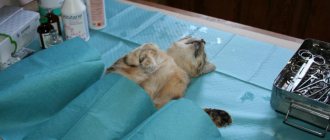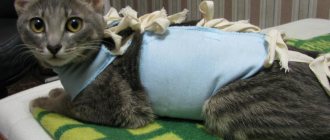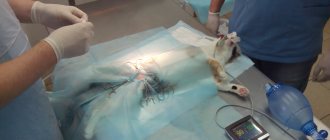If you have doubts about sterilizing your cat and they are connected precisely with the assumption that by sterilizing, you will take away from the cat the joy of motherhood and the enjoyment of the process of conception, then you can safely begin to brush aside all these thoughts, since they do not have any scientifically proven premises. !
Firstly, cats do not experience pleasure during the process of conception, and even on the contrary, the very act of copulation for a cat is associated with certain physical suffering. For them, the process of conception is an instinct that drives them in search of a partner for mating.
Secondly, motherhood for a cat and the actions of caring for baby kittens is also an instinct. Do you remember how cats touchingly protect their newborn kittens, lick them, feed them and take care of them? In fact, from a biological point of view, this is nothing more than an instinct. Having taught kittens the basics of self-care, most mother cats lose interest in them and cease to consider themselves responsible for caring for them. This can be confirmed by the following reactions: cats hiss, do not allow grown-up kittens near their food bowl, drive away annoying playful, annoying offspring with their paws; they run away from them and hide when the kittens can easily do without their mother’s milk. So a sterilized cat does not suffer at all from the fact that she does not bear or feed kittens; for her, there are many other interesting moments in her cat’s life. And such a cat will completely give tenderness, love and the joy of communication to its owners.
An ovariohysterectomy, also known as spaying, is the removal of a cat's ovaries and uterus. Young, non-spayed cats will systematically show signs of fertility (estrus, sexual behavior), and their chances of conceiving offspring are very high when in contact with non-spayed males.
A cat can go into heat as early as four months of age. When a cat exhibits sexual behavior, it experiences serious physiological and psychological suffering, and each cat suffers differently; owners of such cats who do not plan to breed them will also, no doubt, face some discomfort and anxiety during this period. Unfortunately, living with a cat who is in heat can be very frustrating. Cats in heat tend to vocalize excessively. They may be obsessed with trying to escape home. Some cats begin to mark areas of the territory in which they live with urine.
Most heat cycles in cats last between four and seven days. If a cat does not mate during her first heat, she will continue to go through a heat cycle every few weeks until she becomes pregnant or is spayed. Over time, the owners of such a cat may get the impression that their pet is constantly “hunting.” Over time, this can cause severe stress and absolute harm to the cat's health. She may lose weight, lick herself excessively reflexively, and even begin to exhibit behavioral problems and may become more aggressive.
Optimal age for intervention
Animal lovers often wonder whether it is possible to sterilize a cat while walking. It's best to do this as early as possible. For example, recommended age:
- 8 months;
- 10 months;
- 1 year;
- 1.5 years.
Babies easily tolerate sterilization, complications are rare
By completing the procedure at eight months, the owner is guaranteed to solve the problem of unwanted pregnancy once and for all. However, animal owners are often afraid that too early intervention can harm the fragile body. These fears are unfounded. If the cat is healthy, no problems should arise. The main thing is to follow all the recommendations of the attending veterinarian.
Important! Difficult childbirth is much more dangerous for a young female.
The younger the animal, the easier it will tolerate the effects of anesthesia.
Childbirth before sterilization: is it possible or not?
Veterinarians do not recommend allowing mating to prolong the birth before surgery. The fact is that against a hormonal background, cats’ “walking” occurs due to the production of the hormone estrogen. Moreover, at first it is produced in some ovaries, but if the cat has already given birth to at least one kitten, female sex hormones begin to be produced by other endocrine glands.
Therefore, sexual behavior and desire for a cat in a pet may still last, and in some cases even remain forever.
Signs of estrus
To attract males, females use 2 tools: voice and smells. All sounds made become rougher and louder. Frequent but light urination occurs not only in the litter box - the pet leaves odorous marks on vertical and horizontal surfaces. Raising her tail and turning her back towards the target, she secretes a few drops of urine.
Another way to place marks is by rubbing them on objects. The glands on the cheeks of furry pets secrete a special secretion, allowing them to leave an individual scent.
The signs of the first menstruation are identical to subsequent ones. They are distinguished only by their weak expression in young animals.
Remember that discharge during “critical days” should be transparent. The appearance of blood or pink clots is a dangerous symptom that requires diagnosis.
Caring for sterilized animals
Another important question is how to care for your cat after surgery. As a rule, after an intervention carried out along the white line of the abdomen, the owners face special difficulties only in the first week after the operation. If you chose a more expensive laparoscopy, then difficulties in care will only arise on the first day after anesthesia. Cats, as a rule, tolerate intervention more easily. Immediately after the anesthesia wears off, they feel quite well.
After sterilization, it is important to give lighter food to male cats; it is best to switch the animals to special brands for castrates. Remember that caloric needs after surgery are reduced by 30%. It is not advisable to give natural food to castrated animals, since it is very difficult to choose the right diet in terms of calorie content. It is important to follow your veterinarian's recommended amount of food to prevent obesity.
It is important to play with sterilized cats, as owners often feel sorry for them and do not touch them for a long time. Try offering your pet rustling and ringing balls and artificial mice; perhaps these toys will attract his attention and distract him from stress. After all, any operation, even something as routine as sterilization, is still stressful for the animal’s body. However, cats quickly forget about this, and the benefits for their health are much higher than any inconvenience.
Sterilization of cats, when is it better to sterilize a cat and castrate a cat, how and when to perform surgery on your animal - these and other questions will be discussed in more detail by the veterinarians of our clinic.
Watch a video about the sterilization operation:
How is sterilization different from castration?
The standard procedure for removing the uterus is carried out in all veterinary clinics. Proper preparation reduces all risks to a minimum. It is recommended to begin preparations at least two weeks before the intended sterilization.
To properly prepare your pet for medical intervention, you must:
- take blood tests;
- take a general urine test;
- undergo an examination by a cardiologist and do an ECG (especially if the animal is 7-8 years old);
- do an ultrasound (according to indications).
If any abnormalities are detected, the operation will be delayed.
Attention! Before carrying out the manipulation, it is necessary to carry out unscheduled treatment against worms and vaccination against rabies. Data about these procedures are entered into the animal’s veterinary passport. Without this information, the cat may not be allowed on the operating table.
Technique
You can castrate a female in the first two days after the start of estrus. An incision is made in the animal's abdominal cavity, the uterus is excised and removed, and then stitches are applied. After this manipulation, the cat will need to wear a blanket for a long time to prevent infection of the stitches.
After sterilization, the owner’s main task is to provide the cat with peace and not let it go outside. Also, the animal should be protected from sudden changes in temperature and fed moderately, because heavy food can cause vomiting.
After surgery, your pet may feel chills or nausea
Attention! After surgery, the animal may behave aggressively or, conversely, lethargically. This is how the delayed effect of anesthesia manifests itself. There is no need to worry - this phenomenon passes quickly.
We suggest you read: If you are bitten by a rabid cat: symptoms and signs of rabies in a person after being bitten by a cat or cat, is there a rabies vaccine for people
Removing a cat's uterus surgically has many benefits, such as:
- protection from unwanted offspring;
- increasing the life expectancy of the animal;
- improving the cat's character;
- normalization of hormonal levels.
But most importantly, the cat will begin to behave calmer and will not ask to go for a walk. This is especially important for owners who keep pets in large cities, where pets cannot be left unattended for a long time.
In order for the animal to safely undergo castration, the cat must be properly prepared for medical intervention. This will help avoid serious postoperative complications and psychological stress. If everything went well, the cat needs a good gentle regimen for at least a month. Then she will quickly regain her physical strength and finally recover.
During surgical sterilization, obstruction of the tubes leading from the ovaries to the uterus is created. The sperm will not meet the egg and fertilization will not occur. Of course, in this case there will be no more kittens and there is no need to worry about accidental matings. But sexual attraction remains.
If there is no fertilization in the cat, estrus will begin again after 2 weeks or an imaginary pregnancy will develop, which can easily be confused with the real one. An attempt to deceive nature most often ends in hormonal imbalances, giving rise to a tumor process.
Castration is the removal of the ovaries and appendages. It is this solution that allows you to save the cat and those around you from the torment that accompanies estrus. If the operation is carried out carelessly and a piece of reproductive tissue remains, there will be no discharge from the loop, but the animal will not get rid of periodic meowing.
Therefore, the term “sterilized” should mean a castrated cat. Often the uterus is also removed along with the ovaries. Deprivation of genital organs alters the female's metabolism and behavior. Therefore, you will have to forget about natural food and cheap economy class food.
For sterilized cats, special foods are produced that prevent obesity and related diseases.
Be sure to read:
Is it worth castrating a cat: optimal age, is it harmful, what will happen if the operation is not performed
Abdominal surgery is performed under general anesthesia. Since pets are prone to vomiting, the cat is not fed for more than half a day before surgery.
Be sure to read:
We suggest you read: How to find out the gender of a red-eared slider
Castration of a cat: how it happens: how it is done, methods, what is removed and at what age
There are several methods for removing reproductive organs, in which the ovaries with appendages or uterus are removed through an incision, a ligature is applied and bandaged. At the request of the cat owner, the veterinarian applies an intradermal suture, which is processed once on the operating table.
What are the benefits of sterilization?
The benefits of sterilization far outweigh the risks of surgery and include:
- preventing the risk of developing breast cancer (with early sterilization), since removal of the ovaries reduces the level of hormones that promote the growth of cancerous tumors;
— significant reduction in the risk of cervical cancer;
— reducing the risk of developing ovarian cancer;
- unsterilized cats often suffer from pyometra - an inflammatory disease of the uterus;
— preventing the appearance of unwanted offspring, which is especially important for cats living in private homes and free-ranging;
— prevention of noisy sexual cycles that cause suffering to the pet and discomfort to the owners;
— prevention of cat marking of territory and the smell of urine from the cat in the house;
- By spaying your cat, you will reduce her desire to travel, run away from home in search of a mate, and find that she is absolutely happy to stay in a safe, comfortable place next to you on the sofa.
Some veterinary drugs can be used to suppress sexual behavior in cats, but they are strongly discouraged for long-term use as they carry a significant risk of serious side effects in cats and may cause harm to the cat's health if used chronically. If you do not intend to have offspring with your cat, neutering will eliminate her sexual behavior, the possibility of pregnancy, and the risk of reproductive diseases later in life.
Changes in physiology and behavior
The first heat or estrus begins in cats after the completion of puberty at 6–10 months, in large breeds later. From this moment on, it repeats regularly, accompanied by hormonal surges and behavioral changes.
The sexual cycle consists of the following stages:
- The preparatory period , proestrus , lasts 2–3 days. Under the influence of the gonadotropic hormone of the pituitary gland, the growth of ovarian follicles begins, and the secretion of estrogen increases. The uterus swells, its walls thicken, and a liquid transparent secretion is released. The reproductive system prepares for mating and ovulation. The pet becomes excited, fawns over its owners, meows, scratches surrounding objects, but does not let the cat near.
- The second stage , estrus , lasts 6–7 days. The concentration of estrogen increases, the uterus prepares to accept and store the embryo. The female makes guttural sounds, inviting a partner, crouches to the floor, raises her tail, and walks on bent legs. She runs to the litter box more often, marks her territory, hardly eats, and drinks a lot. The vulva enlarges, clear mucus without blood is secreted, which the animal licks. During mating, the secretion of luteinizing hormone increases, which stimulates the rupture of follicles. After ovulation, the amount of estrogen decreases sharply. The ovaries form the corpus luteum, which secretes progesterone. Under its influence, the endometrium thickens, and the uterus awaits the embryo. Fertilization occurs 1–2 days after mating.
- The third stage , metestrus , lasts 8 days. After ovulation, the sexual instinct dies out, the female ceases to be interested in cats, and behavior returns to normal. If fertilization does not occur, the concentration of progesterone drops, and physiological changes are repeated in the reverse order. Sometimes an animal begins to have a false pregnancy. If the female does not meet a partner and mating does not occur, the cycle repeats after 3 weeks.
Indications and contraindications
There may be the following indications for sterilization:
- No need for breeding. If you are not planning kittens, you should think about sterilization. Every heat is stress for the body. They can recur in cats at intervals from several days to several weeks. The body will restart this cycle until fertilization occurs. Often, instead of pregnancy, hormonal disorders occur, leading to serious consequences and even cancer.
- Tumors and cysts of the reproductive organs.
- Inflammatory processes in the uterus. This could be pyometra or endometritis (inflammation of the uterus with or without pus). Such diseases are difficult to treat, and there is often a risk of rupture of the uterine wall. Removing the affected organ is the only way to help your pet.
- Pathologies of pregnancy and childbirth. If the kittens die during gestation or the cat cannot give birth, she will need urgent surgery.
Contraindications to surgery may include:
- Diseases of the internal organs: inflammation of the liver, kidneys, periodic vomiting against the background of chronic enteropathy, etc. In such cases, it is worth first restoring the health of your pet and only then contacting a surgeon for scheduled sterilization.
- Diseases of the respiratory system: respiratory tract infections, chest injuries, diaphragmatic hernia, etc. During anesthesia, breathing slows down a little, and if the pet is unwell, then the risk of complications during anesthesia greatly increases.
- Diseases of the cardiovascular system: hypercardiomyopathy, defects, congestive heart failure increase anesthetic risk.
- Blood diseases: coagulation disorders, hematopoietic pathologies, red bone marrow diseases, oncology, etc. In this case, any surgical manipulation is dangerous.
- General malaise, underweight, etc. We are talking mainly about animals picked up on the street or taken from shelters. The cat may be stressed, eat poorly, hide, or be too thin. You need to let her get used to the house, to you, and monitor how she feels. If the weight is too low and bones are visible, then first you need to fatten up your new pet a little. Then recovery after surgery will be faster.
It is important to clarify that if the operation is necessary for medical reasons (pyometra, pathology of pregnancy), then the doctor may decide to sterilize, despite contraindications, since these diseases threaten the pet’s life.
Is it possible to spay a cat during heat?
If a cat's heat is progressing normally, veterinarians recommend waiting until it ends and only then operating. With pathological estrus, when the cat constantly screams, but there is no discharge from the loop, there is a high probability of developing a cyst in the ovary or a tumor. Estrus occurs without characteristic signs.
In such a situation, it is necessary to carry out diagnostic procedures and prepare the animal for surgery. Sterilization during pathological estrus is not only possible, but also necessary.
If the operation is performed on a current female, the following factors must be considered:
- the genitals are filled with blood, the risk of bleeding increases;
- a sharp cessation of secretion of the gonads during a period of increased activity leads to hormonal disruptions;
- older animals may have chronic diseases for which anesthesia is contraindicated;
- After surgery, estrus may continue for some time, which raises doubts among owners about the success of the operation.
If the decision is made, in the first days of the hunt they sign up for a planned operation and follow the veterinarian’s orders to prepare for sterilization. The favorable time is the anestrus phase, when the concentration of hormones and the fullness of blood vessels are reduced.
Estrus is the period when an animal:
- Begins to actively mark the territory.
- She asks to be let out into the street. At this time, even the most domestic cats have a good time walking.
- Waits for intimacy with the male.
- Feels increasing sexual arousal, prepares to become pregnant and give birth.
Owners often try to schedule sterilization at this particular time. However, this theory has many opponents.
Veterinarians' opinions
When asked whether it is possible to sterilize a cat during heat, experts answer differently. Most specialists give a negative answer, because at this moment there is a high risk of hemorrhages during surgery and hormonal imbalances in the postoperative period. However, a qualified surgeon minimizes all risks.
Important! Performing an operation once in a lifetime is much safer than risking the health and life of your pet during childbirth every year.
We suggest you read: How to cure lichen in a cat at home: medications and traditional methods
Sterilization after estrus: recommendations and subtleties?
Almost all experts say that it is beneficial to spay and neuter a cat in the period before the first heat.
If natural processes in the pet’s body have already begun after estrus, you can sterilize the cat after at least a week, when the hormonal levels have subsided somewhat. It is also possible to sterilize an animal during estrus according to the veterinarian's indications. But in this case, the risks of bleeding and other equally dangerous factors increase greatly. Since during estrus the reproductive organs are filled with blood, even the slightest surgical intervention can cause large losses. Therefore, in order not to harm your pet, it is better to wait time and sterilize after the completion of the cycle .
© shutterstock
Post-operative care
After the operation, the animal, while it is still under anesthesia, must be placed in a warm place. It is advisable to lay it on its side and place a heating pad next to it. At the same time, you cannot put her on an elevated place, because after anesthesia she has poor control of her movements and may fall and get injured.
You need to try feeding the next day; you should give wet food in small portions. There are special foods for the postoperative period that have a positive effect on the functioning of the digestive tract.
To prevent the animal from licking the seams and damaging them, it is necessary to put a special collar on it, which is removed only during feeding. Immediately after the operation, the pet must be taken home as quickly as possible and wrapped up, because under anesthesia their body temperature drops. also necessary to turn it over every half hour from one side to the other, and close your eyes so that they do not dry out. It is necessary to constantly monitor him and show him the care that he really needs now.
Preparing for surgery
Before surgery, you must be sure that nothing is bothering your cat. She has no vomiting, refusal to eat, fever or other signs of illness.
To reduce stress, you can gradually get her used to being carried. Lower it to the floor more often, let the cat sniff it, you can try leaving treats inside to reinforce positive associations.
We recommend scheduling the day of surgery on your day off in order to monitor the cat’s condition on the first day.
The doctor, depending on the age and breed of the pet, may recommend:
- Clinical blood test;
- Blood chemistry;
- Echocardiography (ultrasound of the heart);
- In some cases, abdominal ultrasound and chest x-ray.
Immediately before the operation, you need to fast for 6-8 hours.
How long does cat sterilization surgery take?
The operation itself does not last long - from 15 to 30 minutes. But this does not mean that the cat will be given to you half an hour after you delivered it to the clinic. First, the doctor will premedicate, that is, administer medications that will prepare you for anesthesia. Next will be pre-preparation - shaving the surgical field, sterilizing all surfaces, positioning on the operating table, connecting the necessary sensors to monitor the condition, and only then anesthesia and the operation itself. After this, a good doctor will always monitor the patient’s condition during recovery from anesthesia. When the cat fully recovers and the doctor is sure that everything is in order, she can be taken home.
When is the best time to spay a cat?
The ideal time for intervention is when the first heat has passed. This time may vary for different breeds. For some, puberty occurs as early as six months, while for others, not earlier than 10 months.
If you want to perform the operation as quickly as possible, without waiting for the first cycle, it is better to choose the laparoscopic method. A puncture is made in the abdominal cavity, a probe with video sensors is inserted into it, the ovaries are excised and the seams are sealed without suturing them. Within 2 hours after the intervention, the animal can walk; it is not necessary to wear a blanket.
Important! The standard method is more painful, and it is harder for the animal to recover, because this method involves making an incision in the abdominal cavity.
If the first heat has just ended, it is better to plan surgery about a week after the final end of this period. During this period, hormonal levels stabilize, so the animal tolerates medical intervention well.
Experts believe that the optimal age is from 7 to 9 months. By this time the animal has finished growing. Advocates of early sterilization have their own reasons, but most veterinarians are inclined to believe that the female should be castrated after the onset of heat and before the first mating.
By this time, the animal must be vaccinated and dewormed. If the owner of a sexually mature female decides to sterilize, it is necessary to first examine the pet. The clinic will take blood samples to assess your health status and conduct instrumental studies.
Stages of the reproductive cycle in cats:
- Proestrus : During this period, the cat may begin to call for males, but she is not yet receptive to mating. Proestrus usually lasts a day or two. Cats in proestrus usually show no outward signs.
- Estrus (heat) : Over the course of about a week, the cat will be attracted to, calling for, and receptive to mating. During this stage, the cat may make previously uncharacteristic loud sounds, similar to a scream, roll on the floor, rub against objects and lift the back of its body. She may also have a decreased appetite. If a cat mates while in heat, mating stimulates the production of hormones that cause ovulation. To become pregnant, cats usually need to mate four to six times during their heat cycle.
- Intererus : If a cat does not mate or become pregnant during estrus, she will go into intererus. Her estrogen levels drop and she shows no specific symptoms. Over the next few weeks she will go into heat again. The cycle of proestrus, estrus and interestus will continue until conception occurs.
- Anestrus : This is a period of reproductive dormancy for a cat, her reproductive hormones are inactive and there is no estrus cycle. Stray outdoor cats have estrus cycles that occur seasonally from spring to fall. This is because hormone production is stimulated by the light of longer days. When the days are shorter (especially from October to January), the cat has no incentive to go hunting. Domestic cats are exposed to prolonged exposure to artificial light and can therefore continue to undergo sexual cycles year-round.
At what age is it better to sterilize a cat?
The traditional age for spaying a cat is around six months, but veterinary research over the past 20 years suggests that spaying before the first heat cycle has significant benefits.
Postoperative period
The postoperative period takes place at home. The sterilization procedure involves cutting into the abdomen, so recovery can be lengthy and painful.
The pet wears a special bandage for 1-2 weeks after the procedure. Hyperactive individuals are given a collar that prevents the animal from scratching and licking the seams.
For 7 days after completion of sterilization, it is recommended to give the animal liquid food so as not to burden the digestive organs, as well as to drink plenty of clean water.
You should protect your pet from playing with children and other activities so that the seams do not come apart. The seams should be wiped once a day with a solution of Miramistin or Chlorhexidine.
The procedure of sterilization and castration can be difficult for a pet, so it is necessary to provide him with peace and comfort during rehabilitation.
How much does it cost to sterilize cats in Moscow and Moscow Region?
First of all, the price for the operation depends on the sex of the animal and the chosen method. Laparoscopy of cats is the most expensive, while conventional tubal or seminal ligation is cheaper. The cost of sterilization may also depend on the number of additional services included in the operation. Some clinics do not include the necessary medications in the price of the operation, so that the amount looks more attractive in the price list and advertising. Please clarify in advance what services will be provided to you. It is best to choose clinics where preparation will be thoroughly carried out before anesthesia. It is also good if veterinarians monitor the recovery from the state of anesthesia.
If you are wondering how much it costs to castrate a cat in Moscow and Moscow Region,
then it is worth considering the maximum number of clinic offers. Choose those places where you can be offered highly qualified assistance, a thorough examination, and surgery in a hospital or at home. Average prices for sterilization of cats in the capital are 1,500 to 4,000 rubles. This is a simpler procedure, the cost of which depends on the medications used.
Difficulties in determining an acceptable cost may arise if you need sterilization of cats. The price (Moscow and Moscow Region) for this operation ranges from 1,500 to 6,000 rubles. Most often, the clinic sets the cost higher if, in addition to the operation, a thorough examination and care of the animal in a hospital is carried out. The examination is especially necessary for those cats whose age has exceeded five years.
Free sterilization of cats in Moscow is offered by many clinics. They are compensated for the costs of operations from charitable foundations. Veterinary centers hold promotions and discounts for volunteers from homeless animal shelters. Free sterilization is often carried out for pets living in low-income families.
Possible risks
If the veterinarian answers positively to the question whether it is possible to sterilize a cat during heat, he is obliged to explain to the owner all the possible risks:
- Significant enlargement of the uterus makes it difficult to remove it correctly from the animal’s body.
- Sterilization and estrus can greatly impact the immune system if the animal is initially weakened or has chronic diseases.
If the procedure is carried out during estrus, it can provoke an exacerbation of gynecological diseases in the cat.
Surgery during estrus is not advisable
Consequences and possible complications
In some cases, it is not possible to wait for this process to complete. Then you need to be prepared for the possible consequences of the operation:
- Heavy blood loss.
- Inflammatory processes.
- Diseases of the genitourinary system and ovaries.
- Hormonal disorders.
- Long-term restoration of hormonal balance.
- Psychological stress.
- Lengthy rehabilitation.
Accordingly, there is a danger when performing this procedure: severe complications may occur; Sterilizing a cat during heat, the consequences of which can be unpredictable, is undesirable. It is better to postpone it to a more favorable period.
Opponents and supporters of sterilization of pets
Animal advocates advocate sterilization of cats because, in their opinion, this operation has the following number of positive consequences:
- after surgery, the risk of developing malignant tumors of the cat’s organs responsible for reproduction is reduced;
- the habits of the animal change, becoming calmer, more flexible and not eager to go outside with the onset of spring;
- the cat ceases to suffer from cancerous tumors and other diseases associated with the uterus and ovaries.
But there are also opponents to sterilization who believe that any type of surgical intervention leads to irreversible consequences in the animal’s hormonal system . Neutered cats become less active and have an increased appetite, which leads to rapid weight gain. Therefore, such cats require special attention and care.
Brief description of the operation
To minimize possible complications, preparatory measures are recommended. They include not only actions immediately before surgery, but also ongoing disease prevention. In particular, this refers to annual vaccination.
Preparing the animal
Anesthesia weakens the immune system, increasing the risk of infection by harmful microorganisms and parasites. For safety, it is recommended to vaccinate your pet at least a month before the procedure. Treatment for helminths is carried out within 1.5-2 weeks. In the absence of timely vaccination, the cat is given a serum injection that stimulates a stable immune response for 2 weeks.
A few days before surgery, a urine and blood test is taken from the tailed patient. To determine the safe dosage of a narcotic substance, the functioning of the heart and respiratory organs is checked using ultrasound and x-rays.
It is recommended to give up feeding 12 hours before, and water 3 hours before. This eliminates the occurrence of vomiting, which provokes the development of aspiration pneumonia.
Choosing a clinic and veterinarian
Pets that don't go outside are afraid to leave their familiar territory. To minimize stress, it is better to choose a clinic closer to home. Walking distance will eliminate travel by transport, reducing the time you spend outside your usual conditions.
For especially timid pets, calling a veterinarian to your home is a good idea. This eliminates the stress caused by a change of environment and the risk of infection from other visitors. The disadvantage of home surgery is the low sterility and lack of equipment necessary to eliminate possible complications. Most clinics provide both types of services, so the choice is up to the owner.
It is ideal if you vaccinate your animal and take it for routine examinations to the same clinic and to the same doctor. A regular veterinarian is familiar with the characteristics of the body.
Progress of the procedure
After anesthesia is administered to the tailed patient, the hair is removed at the site of the future incision or puncture. The procedure itself is carried out in two ways:
- surgical, involving classical excision with a scalpel;
- laparoscopic, based on the creation of small punctures using endoscopic equipment.
In both cases, after making an incision, the surgeon removes the reproductive organs and applies stitches. They are removable and non-removable. The first ones are removed 7-10 days after the procedure, and the second ones resolve on their own.











